Has one of Portland’s first and most beloved bikeways drowned in car traffic over the last six months?
The data isn’t there yet to say for sure. But Brian Davis, a transportation analyst for Lancaster Engineering and a regular user of Clinton Street on his bike, has written a short, moving essay on Portland Transport about his changing experiences riding on the street. (Emphases mine.)
Just a few years ago, the thought of going two whole months without setting tire upon Clinton Street would have been unfathomable to me. One of the best things about my job is that I get to travel throughout the city to look at roads and intersections, and Clinton has long been my superhighway to all points southeast. If you got there early enough, you could often go from Seven Corners all the way to Southeast 26th without seeing a single car. On my many ambles through the corridor I discovered the best cup of coffee in Southeast, the best corn muffins in the city, and the best hot buttered rum anywhere. I realize now that I developed something of a sentimental attachment to the street while riding eastbound all those mornings, mesmerized by constant stream of people cycling past me on their way downtown. Those sign-toppers really meant something back then.
Neighborhood Greenways, née Bicycle Boulevards, are among the most innovative of Portland’s contributions to bike infrastructure. Because Portland’s density is relatively low, and our city blocks are relatively small, we’ve got a decent number of streets that are naturally low-volume. By identifying some of those streets and making a few modest improvements to them, the city created a fairly robust network of comfortable bikeways, quickly and cheaply. Quintessential “low-hanging fruit.” These would never cut mustard as a substitute for high-quality bikeways along our busiest and best streets, but they could be an excellent complement to them. Certainly, they’d suffice in the interim while we built out all of that truly nice stuff.
While I savored those early morning rides along sleepy Clinton, change was happening quickly a block to the north on Division Street. As the recession eased and development picked up, Southeast Division began to densify as fast as any street in the City. Many hands were wrung regarding where everybody would park, but we forgot to think about where everybody would bike. All the while, car traffic on Clinton crept upward. When the Division Streetscape project hit, it was over. Though the project improved Division Street by adding curb extensions at the expense of automotive capacity, we forgot to plan for the impact to bicycling even though it was easy to see this coming. In the course of detouring cars around the construction, we introduced them to a route that they seem to be sticking with in lieu of a slower, narrow Division. The transformation of Clinton Street from a low-stress bikeway to a vehicular cycling boot camp is now complete.
It’s a timely and well-written piece by a thoughtful traffic pro. You can read the whole thing here.
Advertisement
Is Division Street getting busier?
But is Davis right — has the Division Streetscape project, and related construction, conditioned hundreds of people to switch their driving routes from Division to Clinton, creating what Davis described in an interview as a “white-knuckle experience” for people biking?
The city hasn’t measured traffic on Clinton since early April. However, we can offer a little historical context: auto traffic in the 26th and Clinton area, at least, has been hovering around 3,000 cars a day for at least 20 years.
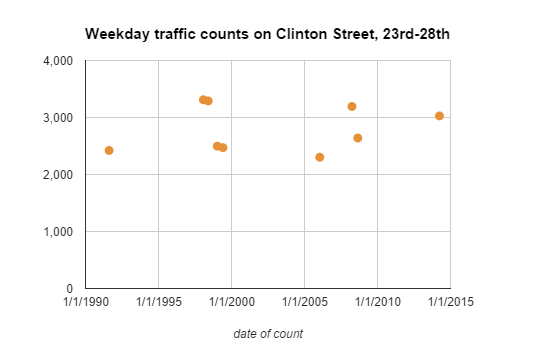
(Source: archived city counts via Michelle Poyourow.)
The above data comes from the files of Michelle Poyourow, a senior associate at local planning firm Jarrett Walker and Associates. These are all the counts on this relatively commercial stretch of Clinton going back to at least 1986.
Here’s a look at a longer stretch of Clinton: every traffic count since 1986 between 10th and 38th.
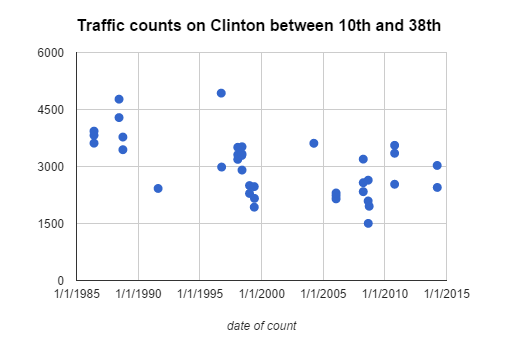
You can see a slight downward trend in auto traffic, which shows up throughout central Portland over this period. But it’s also clear that Clinton has never lived up to the national standard that a bicycle boulevard should carry no more than 1,500 cars per day, or 3,000 on “limited sections.”
It’s clear that many Clinton Street users share Davis’ concern. In August, the new advocacy group Bike Loud PDX formed in response to traffic diversions onto Clinton, convincing the city to add temporary visual barricades during construction but not yet hearing response to their other request: permanent diverters on the street.
In an interview Tuesday, city transportation spokeswoman Diane Dulken said the Portland Bureau of Transportation plans on doing a new traffic count soon, to test the effects of the various runoff, curb and striping changes in the area.
“We do not know at what point we’ll do it,” Dulken said. “We do share the public concern about traffic on the Clinton neighborhood greenway.”


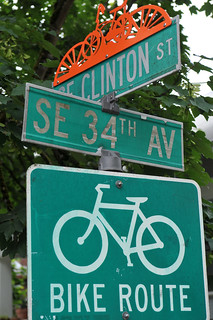
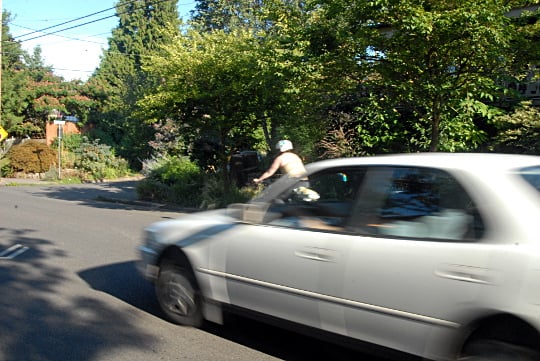

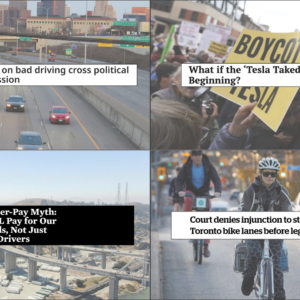
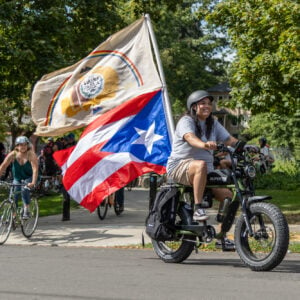
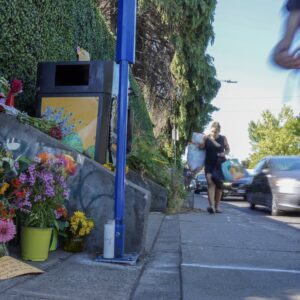
Thanks for reading.
BikePortland has served this community with independent community journalism since 2005. We rely on subscriptions from readers like you to survive. Your financial support is vital in keeping this valuable resource alive and well.
Please subscribe today to strengthen and expand our work.
I find automobile counts to be a disingenuous metric for deciding o diversion. Greenways are meant to be low-stress safe and comfortable for riders of all ages and abilities. Here in NE Portland we are lucky that a typical ride on Going St might not see any cars. But at least once a month I deal with an aggressive motorist doing thier part to convince parents that children shouldn’t be riding on our streets. Wishing and pleading won’t change that.
If we want Greenways to live up to thier name we need diverters every 2-3 blocks. Without that we’ll never see the kind of ridership we want. To all the engineers reading this, remember — it’s not about the median behavior, it’s the outliers we need to contend with. I’ll do my part to get the classification updated to something more consistent with our values. If you or your family rides I’m sure I can count on your help.
I ride Going Street regularly between 10th and 33rd, and that section, at least, is just what a greenway should be. Diverters, good signage, speed humps and – probably most importantly – the nearest busy street being more than a block away, all make it an extremely pleasant ride, as fast or as slow as you want it to be. It seems like there but for a little concrete could go Clinton Street. But Portland likes to rest on laurels from ten and twenty years ago.
Have you ever seen a motorist doing things that would make it less than inviting for an eighth year old? If we want mode share it needs to be inviting, not just tolerable.
That would be the chronic rolling stops on the cross streets.
Yep. It makes me cringe when I see gutter huggers of any age. I still haven’t figured out a polite non-judgemental-sounding way to say “the engineers placed the sharrows there as an indicator of the safest lane position for cyclists” that is short enough to say to other riders as I pass.
The fix I have in mind for the rolling stop signs is, once we have adequate diversion we won’t need speed humps on the bike route any more, so move the speed humps to the cross streets where the stop signs are. For bonus points pave the top of them with sidewalk concrete so walkers / wheelchairs don’t have to go up and down ramps at every intersection.
Yes sharrows do not yet communicate lane position to the novice rider in this region…at least not as well as the fruit, power bars, or banana peels stencilled on Williams a few years ago…
I actually have never considered that that was what they were supposed to communicate until right now. Curious.
Now Mario power ups I’m well-versed in, but I never got bigger, grew a raccoon tail or got extra points when I rode over those, so maybe the city installed them incorrectly.
i want to scream at bicyclists in the gutter, You’re not trash! You’re not wind-blown leaves! You’re not a parked car! You are a vehicle!!
Going has Prescott a block to the south, which is one of the nicest east/west routes for driving in town. Few lights, light traffic (I think people forget that it’s there, but it goes all the way to 82nd..), no speed bumps, and near MLK you would have to be crazy to ride a bike on it due to the narrow lanes.
For the past few years I have admired the contrast between the pleasant-to-ride-on Going, the pleasant-to-drive-on car-only but few businesses Prescott, and the full of pedestrians and businesses Alberta (not good for driving or biking, particularly…)
I don’t think Clinton/Division has anything like a Prescott to divert traffic to as Division changes.
It used to be my primary route home between MLK and 33rd on a bike for all the reasons you state that it’s nice for a car. Before Going was converted, I would hop down to Skidmore to cross 33rd just before that horrid intersection and continue on Skidmore from there. And Prescott is many times smoother than the cracked concrete route of Going. The narrow lanes didn’t bother me, I just took them. I have since stopped Prescott though (mainly due to moving).
That makes sense. I just don’t like riding near cars if I can avoid it. I’ve had more close calls than I want to, so now I treat cars like they all want to kill me. The narrow lane makes it worse, because I don’t feel like I have an easy escape route (plus Going is right there…)
This is wise; never trust anyone on four wheels. It’d be safer still if drivers were actually ticketed for parking on the wrong sides of the street. It’s a behavior I’ve never seen in any other city, and it speaks of a phenomenal degree of driver laziness, apathy, and sheer ineptitude.
Agreed. Very dangerous to pull out blind (because the driver is up against the curb and can’t see around the next vehicle in front of them as the passenger side of their vehicle jumps into the road). This is a huge revenue source for traffic cops that would more than pay for their time and create safer conditions. They are passing up almost-free money.
I also used to ride east on Going/Prescott when I lived out in Parkrose. Going is fine, except that it ends at 72nd and I had to get to 102nd and Mason.
I tried dipping north to catch the Alberta Greenway to 89th, but that was both out of my way and where I met up with the most aggressive road rager I have ever come across.
So I rode Prescott every day between 72nd and the 205 bike path. It is smooth and wide and the only place where I had problems was where it narrows right before crossing over the 205 (and then it widened out again.)
My morning school dropoff route consists of Going from Vancouver all the way to 42nd, and I think that because it’s so slow and peaceful, it makes the occasional passing car seem that much louder and more aggressive, even if they’re only doing 25. I agree with the need for diverters, especially in the 4 or so blocks on either side of 33rd. It’s clear people use it as a collector to get to 33rd. I’m also pleased by how many kids I see on it, not just in trailers or cargo bikes, but riding their own bikes with their parents. I also commute daily on Vancouver/Williams, and that is something you rarely see there.
I always ride directly over the sharrows on Clinton now… people still pass dangerously close while I’m going the speed limit, but at least they likely know they’re doing something wrong when they do it…
I’ve adopted the practice of riding as close to the centre line as I can on Clinton, preventing oncoming vehicles from illegally driving up the middle of the street the entire way while flying by bicyclists riding in the door zone. I feel like this could easily hold up in court; the law requires cyclists to ride as far right as is safe, and there’s no way it’s safe for any of us to ride just beyond the door zone while oncoming cars are whizzing past a foot or two to the left.
The chevrons over the greenway symbol painted on the street is the expected lane position of a bike rider on the street. None of the greenway street markings on Clinton are in the door zone.
You are not only legal riding in the lane on Clinton, you are expected too.
Truth is Clinton is bad, not because of construction or reroutes, it’s bad because people riding bikes have given it away by hugging the far right of the lane. If all the riders took the lane all the time the cars would avoid Clinton and all the other more popular greenways all the time.
The sharrows are intended to be placed in “primary position” — this is the position you see motorists placing thier car in when there is no other traffic on a street. On our narrow Portland streets this is well left of center. This is why when I ride Going I stay on the centerline or a little to the LEFT of it. I find even a hair further right and the number of aggressive passes more than doubles. A simple rubric is to look at the path a cars driver’s seat (and driver’s body) takes down the street. At first it will feel weird and maybe aggressive, but once you are comfortable owning the street it’s actually more relaxing.of course I dip back over to the sharrowed line when there’s oncoming traffic.
No, this is not true. Clinton is too wide for a single bike rider to prevent the average Portland driver from passing, no matter where that person rides. This is a big part of the problem on it.
Same goes on Klickitat/Siskiyou. A few times a season a car insists on passing me (while I’m established squarely in the center of the lane) while I’m already braking the 20mph speed limit.
I also routinely notice, as in every day, that oncoming cars give more space to parked cars on their right than they do the oncoming bike (me) on their left. That is, they’re well over the center of the street in their approach to me.
It’s disheartening.
They are avoiding the door zone, while wondering what the heck it is you’re doing.
Occasionally when they do this I feel as though my safety is compromised, and I’ll either nudge a foot or so over to the left to “encourage” them to move back over, or I’ll motion for them to move over with my hand as if I’m “sweeping” them back. The latter actually works most of the time – most of these people know they’re pulling shenanigans driving down a greenway and they’ll cower a bit when they’re called on it. The same concept works for unmarked crosswalks as a pedestrian. Simply throw your hand up motioning for cars to stop and 90% of the time they’ll obey.
It’s quite dangerous (and I don’t recommend anyone do this), but I have on occasion leaned out & smacked a few oncoming rear-view mirrors with my left hand, just to let the drivers see exactly how close they’re getting when they plow their SUVs down the middle of the street.
That’s because a parked car will still do more damage to their car that you on a bicycle will. I want a jersey that reads “please don’t hit me, I might scratch your car” since that seems more inportant at time time than “I’m a person”
Thanks Kyle for rolling “the people’s diverter.”
Hard to imagine traffic counts on Clinton haven’t spiked this year. Dumb question, but are the latest counts based on motor vehicles only, or are they just taking the raw data from vehicle counters installed on the roadway, which might include bicycles?
Tube counters are not sensitive enough to detect cyclists. The weight of the vehicle must displace enough air to register at the counter. Bikes over the long tubes simply don’t do that.
Granted, this was during the Division construction, but undoubtably the car traffic has gotten worse.
https://vimeo.com/m/106111442
During the construction I found the “Road Closed to Through Traffic” barriers at 26th had been moved out of the way of the lane on multiple occasions…
“We do not know at what point we’ll do it”
There’s another excuse to add to the PBOT Complacency Bingo game.
Clinton needs concrete curb type diverters, similar to what Ankeny has at 20th.
It needs better than Ankeny/20th, more like Harrison/20th. the diverter at Ankeny is regularly driven over.
Most ppl that I have had run ins with have no idea how to drive on Clinton St and pass at the wrong time.
This seems like an issue [again] that should have been included in the pre-construction work zone and detour planning. Why so long?
But there seems to be internal resistance to this until the last moment [not likely ignorance given the high level of experience of the Portland staff but perhaps value engineering / cost containment or institutional silos?]…like the City’s evolution on when to implement the traffic management changes on the parallel route(s) to the Williams arterial project.
Some BikeLoudPDXers, convened by the inimitable Kari, are meeting on Sunday, 10/26 at 4pm at Imperial Bottle Shop, 3090 SE Division to strategize for how to get diverters on Clinton. Diversion on Clinton is on the Richmond Neighborhood Association agenda for November 10th, so coming up with a coherent, well-reasoned proposal is good. Also showing up at the Neighborhood Association meeting to express support is super good!
We also need to work on the Hosford-Abernathy Neighborhood Assocation but one thing at a time!
Reading this again, it didn’t seem explicitly welcoming. Anyone is welcome to come to the “Drinks and Diverters” event at 4pm on the 26th!
You might inquire with PBOT if any preliminary plans or concepts have been developed.
Drivers, particularly commuters, have clearly realized that Clinton is a great cut through street. Fast, no/few stop signs- and why not? There’s nothing to stop you. It’s like it’s perfectly OK!
Well, it’s not. And it’s time to make that clear. What’s keeping diverters from being put in?
I’ll bet if you asked 100 Portland drivers what “Those sharrow things are”, at least 95 would say “They’re to tell bikes which way to go”. They wouldn’t say anything close to “They’re to remind car drivers to share the road, that this street is bikeway”.
Diverters, now those, car drivers understand those. So…. why not put ’em in? Is it a neighborhood street or a mini arterial? Hmmm?
And don’t get me started on speedbumps. We all know speedbumps are for everyone else that speeds. They don’t mean YOU should slow down, just that you only get to go as fast as you’re comfortable taking them.
Diverters? A little harder to ignore.
Traditionally, diverters were seen as a tool of last resort. With the creation of Neighborhod Greenways, a new class of roadway where the vulnerable users is given priority, that pardigm of ‘tool of last resort’ is changing.
So, to answer your question 1) Diverters inconvenience local residents, and inconvenience those closest to them the most. Convenience is a neighborhood livability issue. With NGs we are basically saying the needs of a group of through traffic, cyclists, outweighs the wants of local residents. I have no problem with that, but it is a policy change that requires vetting and approval.
And, 2) Diverters that are effective tend to be expensive. Less movable is better. Mult-beneficial is better than ‘just stop the cars’ (think pocket parks as the penultimate facility).
3) Clinton is no longer a purely residential neighborhood. Small clusters of commercial need better access for customers and deliveries to remain viable.
I hum this song to myself every day when I am biking down Clinton: http://www.youtube.com/watch?v=sAXLlVnL72Q
It appears that the Clinton Diverter issue gets passed around at PBOT, I recall hearing staff talk about it, but nothing ever seems to get done.
The BikeLoudPDX Postcard campaign targeted Commissioner Steve Novick as someone who can do something about the impasse. He’s at the top, he’s in charge, it is in full conformity with the 2030 Bike Plan, NACTO bicycle design guidelines, and common sense.
We had over 150 postcards sent in to him.
If you feel strongly that diverters on Clinton should be expedited, I’d suggest dropping Commissioner Novick a message, via email, snail mail, or voicemail. Every voice counts.
http://www.portlandoregon.gov/novick/
And, if you live in or near Richmond or Hosford-Abernathy neighborhoods, attend the meetings or email your thoughts to the board.
Thanks for the coverage, Brian and Michael,
Ted Buehler
Since Novick is unresponsive, it makes sense to take the question to Council, so he can be unresponsive in public. It should be a fairly simple process for someone who bikes Clinton regularly (or would if it wasn’t broken) to sign up for a communications slot. The more the merrier: http://www.portlandonline.com/auditor/index.cfm?&a=63123&c=34447
I will definitely be emailing Commissioner Fish!
Fish!
After speaking with some folks in the know at yesterday’s wonk night, it seems the right person to prioritize this is not Novick but Leah Treat. Her email address is leah.treat@portlandoregon.gov — she’s also a bike commuter, so be kind but firm when you express your support for effective diverters on Clinton.
TB,
How about a fund-raising event for the estimated $80k to $120k to do the project correctly?
Right after that gas tax gets passed.
Actually it is OK. This is a city street and cars are allowed to drive on streets. If diverters are installed cars will still be allowed to use the street for local access.
“Legal” and “OK” are two different things. I think most people hate cut-through traffic on their street (or know they would hate it, if they were lucky/wealthy enough to live on an otherwise quiet, residential, reserved-by-government-mandate-for-single-family-homes-only street), and should be able to figure out using the Golden Rule that being cut-through traffic on someone else’s street is not a Good Thing To Do.
I used to live on Marion between 17th and 13th in Sellwood, and I was one of the petitioners who persuaded the City to install speed bumps because this was a classic cut-through street in the grid system. What pissed me off was fast and rude drivers, not simply drivers.
Continue on your goal to get diverters installed. I use Clinton on my commute from SE 26, and although I don’t feel threatened by the car traffic there I am not surprised that some do. Meanwhile car drivers are entitled to do what is legal. Good luck getting “Golden Rule” enforcement, there are no courtesy police.
Yep, there are no human Golden Rule police. That’s why we’re trying to hire some concrete ones (diverters) 🙂
AR,
I’m going to presume it is the vehicle of choice the cut-through users are using you object to, not the behavior itself. (Cyclists are technically cutting through the neighborhood)
Yep, I’m talking about car cut-through traffic. It’s car cut-through traffic that tends to be most bothersome to people, and I think that’s what most people think of when they hear the term “cut-through traffic.” Bike cut-through traffic does rile some people up too (see Ladd’s Addition) but neighborhood greenways / bike boulevards have been designated by the City as places for bike cut-through traffic. Neighbor complaints about it shouldn’t be seen by the City as a legitimate reason to discourage bike traffic on those streets. Unless it’s as a reason to create awesome protected or wide, buffered bike lanes with no adjacent car parking on the nearby major streets in order to redirect a good portion of the bike cut-through traffic to those new, awesome facilities, in which case I’m OK with it 🙂 .
Division has become less of a thru street. Is the suggestion to “divert” Division traffic to Powell and Hawthorne?
Auto traffic in all of Central Portland is down considerably in the last decade. So yes, there’s plenty of free capacity on Powell (especially) to absorb thru-traffic that would have taken Division in years past. What we don’t want them to do is drive on Clinton instead. Or Lincoln, for that matter.
Is Powell really a reasonable, using reasonable with a certain vagueness, expectation for auto drivers, who would have typically used Division? How is this to be prevented in the future? And are we looking at a similar lack of scope with “improvements” on Williams, etc?
What I’m really getting at is Division being the root of Clinton’s issues. We’re approaching solutions in this forum from a perspective of bikes, but there are many stakes to consider now and, more importantly, before the city approves in-fill and low parking in conjunction with trendy destinations that exist in the middle of real neighborhoods.
Good question, I think the city needs to grapple with it. Personally, I’m solidly on the more-development, densification side. A quick version of my view: change is inevitable, our choice is densification in Portland or sprawl in the suburbs/exurbs, and we desperately need density to be what happens rather than sprawl in order to save the planet.
But in this particular case, as Michael shows above in the graph, Clinton was already dependably over-volume and uncomfortable before the Division boom and streetscape changes. So although the changes on Division have sent this to the boiling point, they’re really not the biggest underlying cause of this problem.
As to whether drivers will go to Powell, no, probably not all will go there. Some people live north of Division in the 50s, say, and they’ll probably opt for Hawthorne or staying on Division if coming from points northwest.
But I’d say that for the majority of the thru-traffic on Division that’s tempted to cut through on Clinton, Powell is a reasonable option – the City just needs to encourage people to drive there rather than Clinton. Just my guess. We’d need an origin and destination study to know for sure.
Also – congestion on major auto routes is not the end of the world – and may even be a good thing – as long as the City protects biking, walking, and transit from being unduly impacted by the congestion. Congestion reduces speeds and therefore serious injury accidents, and provides a disincentive to driving.
I see a lot of people in the morning coming from Powell and using Clinton as a cut through. Especially below 39th.
Thank you, Michael, for highlighting this. It’s kinda humbling, really.
Given my line of work, I often try to argue for bicycling from an analytical, problem solving-based perspective. As an engineer I’m intrigued by bicycling because it appears to be a genuine silver bullet, capable of addressing pretty much every major problem with our transportation system for a comparatively minuscule cost. The fact that I’m a car-free Portlander who relies heavily on a bike to access the city is incidental.
But try as I might, I cannot help but take the demise of Clinton Street rather personally. I used to love to ride there and now I cannot tolerate it.
I’m very curious to see what volumes are post-Division construction. While I’d guess from my own experience that volumes slowly but steadily trickled up since 2010ish (indeed, the small amount of data we have since then appears to show this), I’m fairly certain they increased dramatically over the course of 2014. But as many commenters smartly pointed out, perhaps daily volumes aren’t the best proxy for assessing the “comfort” of a bikeway. Sadly, this is a much harder concept to tease out. The daily volumes certainly matter, but so to does the distribution of traffic across the day, the motor vehicle speeds and aggression, the number of other bikes, etc. After all, I believe a Commercial Greenway could work for a ~7,000 ADT street like 28th, but I see Clinton failing at something like ~4,000 ADT. Other factors matter.
This is a good segue to tonight’s Wonk Night. Is the upcoming Comp Plan a viable tool to codify some standard of comfort for our most important bikeways? And what should that standard be?
If Better Block can analyze ~60 hours of continuous video of their experiment to come up with things to try in the next round, we can certainly quantify the number of bikes passed by cars. I think that would correlate to comfort a lot more than the number of cars. And if a route has lots of slow school children on it, it will rightly amplify the number as they’ll get passed more per trip than faster bikers.
I don’t understand what the holdup is.
It sounds like the residents want diversion.
It sounds like the cyclists who are supposed to be prioritized on the street want diversion.
The section where diversion is most needed is SE 28th to SE29th. There are practically no businesses along this stretch, so that nips that potential thorn straight in the bud.
I don’t understand PBOT’s continued hesitancy. I really, really don’t.
Government bureaucracies are still mired in the 20th century, when car was king and we could never run out of anything.
Which residents have you asked?
Also – why not do what PBOT did on Rodney, and install a temporary concrete diverter to monitor?
This pilot run would go a long way to assure residents or businesses with concerns.
PBOT formerly did temporary diversion to test the impact. Wheel curb stops, like used in parking lots, where just nailed into the road, and could be reused. When PBOT moved away from diversion as a tool, the wheel stops went away as well. Seems like an idea whose time has come again.
NE Tillamook, between Williams & 15th, is used as a cut-through, and that use seems to be increasing. cars don’t feel they should have to use any of the multitude of streets going east-west but instead should be able to zip through on these “unused” streets. if the City has the least bit of desire to make Greenways work, they could actually ticket the drivers doing over 20 on those streets. and yes, more diverters. start with one at Tillamook & Rodney. it’s not a drag strip for cars in a hurry.
Tillamook, Flint to Sandy, is still in boulevard status, but is on a list to be upgraded to NG status. Volumes are low east of MLK. What is is primarily missing is traffic calming. West of MLK and east of 21st and 33rd is where traffic volumes are a problem. The trick at Tillamook/Rodney is the intersection to two, eventual, greenways, and how to work that.
What about staging sit-ins to where no cars can pass on Clinton, or some other more radical protests that send a clear message that were not putting up with it? Or maybe a little more subtle, like sorry my car broke down right in the middle of the street preventing any cars from passing through.
The City is dragging its feet on even installing signage that discourages through traffic, so we really need to fill this void ourselves until we get diverters.
Also, Lincoln is suffering the same problem, with even faster speeds because its wider.
I mentioned on twitter that I’ve seen car traffic increasing over the years on SE salmon as well, particularly during the rush hours when Hawthorne or Belmont gets backed up. It’s gotten to the point on some days that I’ve thought of just going over and biking up Hawthorne instead, because at least then if I”m hit by one of those agressive pass-to-close-while-going-too-fast drivers, there will be plenty of witnesses and hopefully someone to help me out.
Not to mention all the people cutting through going north/south who barely stop at the stop signs. It’s pervasive enough that if I see a car driver approaching from a side street on a path that will intersect mine, I automatically slow down and prepare to stop- assuming they will rush to try to get in fron of me, if they bother to stop at all.
I’d love to see diverters on all the dignated greenways.
that was supposed to be “designated”
I agree Salmon between 12th and 20th is a real problem. I stopped using Salmon for my west-bound commutes after nearly colliding with motorists on multiple occasions. Hawthorne works better for me west bound.
Have you requested enforcement via 823-SAFE?
Just make them a little more substantial than the ones on Ankeny. SUVs plow over them all the time.
It is useful to look at Clinton in two sections: above and below SE 26th. The entire section needs diverters.
I have been riding on Division recently in favor of Clinton below 26th. The road diet and new surface there and still WIP to cross the 11/12 ave couplet make this more inviting than ever before.
Anyone else see the engineered right hook they are building at Clinton and 12th? This Tri-Met project intersection is a disaster and work seems to abandoned since some earleir work last year. They need to finish this bike/ped infrastructure and get it right.
City needs to get bold and creative at 26th and Clinton intersection as part of 20s bikeway. This has potential to be great for biking. Currently not great. And so close to the area middle school.
Lastly, road surface from 26th to 12th on Clinton is miserable – I have been riding through the same bleeping failed road surface patches and utility contractor cuts for the last 20 years. Makes me want to get in my car and save my back the pain.
PS. If you ride down the middle of Clinton, don’t be surprised if l pass you on the right or the left. Bikes need to pass bikes, also. Any car diverters should allow for multiple bikes to pass through simultaneously and without restrictions to flow. There is a hill.
The question I have for the decision makers is: Given the new configuration, why WOULDN’T cars use Clinton to avoid Division?
They are both 25mph, except for the weak-sauce “20mph when children present” sign on Clinton.
As mentioned in the Requiem above, with the curb cuts installed on Division, they are both now 2 lane roads.
Pretty much every red light on Division is matched by a simple stop sign on Clinton.
There seem to be more pedestrians crossing Division than Clinton and more marked crosswalks (and most drivers think, and most enforcements reinforce the notion that the only crosswalks are marked crosswalks).
There are now more cars on Division slowing down to park along with more tourist drivers trying to figure out where Pok Pok and Salt & Straw are.
We can all wish that drivers will stay off of Clinton out of the goodness of their hearts, but we know that this won’t be the case. Until diverters are installed, this will only get worse. Please don’t wait for there to be an ugly collision or confrontation. It’s coming.